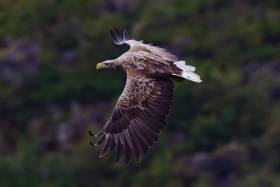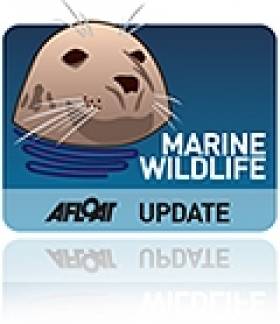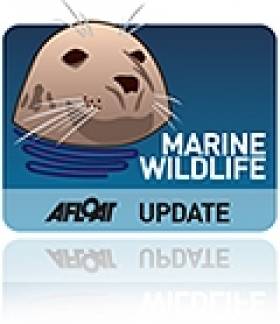Displaying items by tag: Sea Eagle
Wildlife service staff released 21 white-tailed sea eagle chicks to the wild over the weekend at four sites in Munster, including Lough Derg and the Shannon estuary.
Chicks were also released in Waterford and Killarney National Park as part of the second phase of the State’s re-introduction programme.
The National Parks and Wildlife Service (NPWS) said the chicks had been kept in purpose-built enclosures at the four locations while they “grew, matured, and developed the feathers and muscles necessary for flight”.
“They were carefully monitored and tagged by NPWS staff leading the collaborative reintroduction programme, which began in 2007,” the NPWS said.
Satellite tagging facilitates monitoring of their progress and their integration into the existing Irish breeding population, it said.
The chicks were collected under licence in June of this year from nests throughout the Trondheim area of west-central Norway by the Norwegian Institute for Nature Research.
The white-tailed sea eagle once bred on the Irish coastline and near large freshwater lakes, living on fish, waterbirds and dead animals, until driven to extinction in the 19th and early 20th centuries.
 Overseeing the Release of the chicks in Killarney National Park, from left, Regional Manager National Parks and Wildlife Service, Dr Allan Mee, Advisor, White Tailed Eagle Project Phase 1, Danny O'Keeffe, National Parks and Wildlife Service district conservation officer, Philip Buckley, Project Site Manager, Shannon Esturary. The chicks have been kept in purpose-built enclosures at the four locations while they grew, matured, and developed the feathers and muscles necessary for flight. They will continue to be carefully monitored and by NPWS staff leading the collaborative reintroduction programme, which began in 2007. Photo: Valerie O’Sullivan
Overseeing the Release of the chicks in Killarney National Park, from left, Regional Manager National Parks and Wildlife Service, Dr Allan Mee, Advisor, White Tailed Eagle Project Phase 1, Danny O'Keeffe, National Parks and Wildlife Service district conservation officer, Philip Buckley, Project Site Manager, Shannon Esturary. The chicks have been kept in purpose-built enclosures at the four locations while they grew, matured, and developed the feathers and muscles necessary for flight. They will continue to be carefully monitored and by NPWS staff leading the collaborative reintroduction programme, which began in 2007. Photo: Valerie O’Sullivan
The birds are particularly vulnerable to illness and poison in winter when they rely more heavily on carrion.
Most of the birds re-introduced to Ireland over the past 13 years – in a programme pioneered by the Golden Eagle Trust - have remained, while some were reported in Northern Ireland and at least seven birds were identified in Britain.
At least ten white-tailed eagle pairs held territory across four counties last year - in Kerry (7 pairs), Galway (1), Tipperary (1) and Cork (1).
 A white tailed sea eagle chick Photo: Valerie O'Sullivan
A white tailed sea eagle chick Photo: Valerie O'Sullivan
The NPWS says at least nine pairs laid eggs in Kerry (6 pairs), Cork (1), Tipperary (1) and Galway (1).
The NPWS says that “restoring this lost flagship species to Irish skies will be a significant step in restoring Ireland’s natural heritage and will bring great benefit to Irish biodiversity”.
It says the project “underlines in practical terms Ireland’s commitment to implementing the UN Convention on Biological Diversity”.
Sea Eagle Fledges In Bantry Bay
#SeaEagle - West Cork was witnessed its first sea eagle fledging in more than 125 years, as The Irish Times reports.
Local birdwatchers have been observing the young white tailed eagle since it left its nest on Garnish Island in Bantry Bay a fortnight ago.
The fledgling marks the first success for the seabird species in the county since a number of Norwegian birds were released in Killarney as part of a sea eagle reintroduction programme between 2007 and 2011.
The Irish Times has more on the story HERE.
Lough Derg Eagles to Soar Again This Summer
#seaeagles – The popular White Tailed Sea Eagle Viewing & Information Point at Mountshannon Pier in Co. Clare has reopened to the public following a hugely successful pilot opening period last summer.
More than 10,000 people flocked to the shores of Lough Derg between mid-July and September 2014 to catch a glimpse of the first successful breeding pair of White Tailed Sea Eagles in Ireland in 110 years.
The Viewing & Information Point is operated by the Mountshannon Eagle Group, in conjunction with the Golden Eagle Trust and Mountshannon Community Council. It features telescopes and information and displays about the White Tailed Sea Eagles, regarded as Ireland's largest and most spectacular breeding birds.
Clare County Council, which funds the facility, says the facility generated more than half a million euro for the local economy in 2014. A visitor survey conducted last year found that 43% of people said the attraction was the primary factor influencing their decision to visit Mountshannon.
The Mountshannon breeding pair of eagles, a seven-year-old male and six-year-old female, were originally collected as chicks on the island of Frøya off the west coast of Norway by the Golden Eagle Trust. The birds were released in Killarney National Park before relocating to Lough Derg in 2011. The pair, named Saoirse and Caimin, created history in 2013 when they reared the first chicks to fly from a nest in Ireland in 110 years. The pair successfully hatched another chick in 2014 with the local community in Mountshannon expressing hope of another successful hatching this summer.
"Our trial opening in 2014 shows there is significant and genuine interest amongst the general public in these wonderful birds. People are especially fascinated by how and why the birds have settled and began to breed in Lough Derg. This project also demonstrates the potential in terms of tourism product development at this location," said Congella McGuire, Clare Heritage Officer.
Ms. McGuire noted that the visitor figures compare well to the Island of Mull in Scotland where White-tailed Sea Eagles watching has been popular for more than 10 years. A greater percentage of people came to Mountshannon (43%) specifically to see the Eagle pair than to the Island of Mull (23%) where eagle tourism brings in an estimated £5 million annually.
"Clare County Council is delighted to have played a leading role in increasing public interest in the local White Tailed Sea Eagle population without disturbing them in their natural habitat. By doing so, the Council is playing a key role in safeguarding these protected birds and their nesting activities as well as providing an excellent addition to the local tourism infrastructure," Ms. McGuire added.
Sea Eagle Poisoned In Connemara 'Was About To Lay Eggs'
#MarineWildlife - The remains of a sea eagle – or white-tailed eagle – have been found in Connemara, and experts say the bird was poisoned.
RTÉ News reports on the discovery earlier this month of the female eagle, which was "within days" of laying eggs.
She was one of a pair that settled in the Roundstone area of Galway after her release in Killarney six years ago. Last year the pair laid eggs but they did not hatch.
The gruesome find marks the 13th poisoning of a sea eagle since they were reintroduced to the wild, and comes just weeks after the remains of another white-tailed eagle were found in Fermanagh.
Sea Eagle Remains Found In Fermanagh
#MarineWildlife - "A sad end to a beautiful bird" is how the Golden Eagle Trust described the news that remains of a white-tailed eagle were found near Lower Lough Erne in Co Fermanagh earlier this month.
As RTÉ News reports, Ingar was released in Killarney National Park in 2011 as part of a reintroduction programme for the species, also known as the sea eagle.
That same programme saw the introduction of Ireland's first breeding pair of white-tailed eagles in over a century.
Saoirse and Caimin reared their first chicks in 2013, and the birds of prey have proven very popular in Lough Derg, where they relocated from Killarney in 2011.
Ingar's GPS transmitter showed that he had flown to different climes further north, spending the majority of last year on Lough Erne - though it stopped transmitting in December.



























































